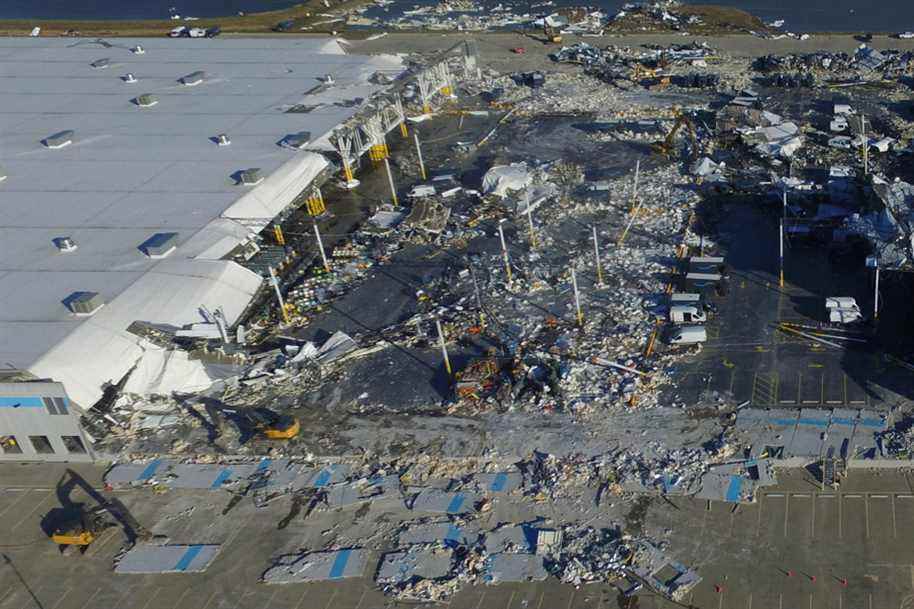(Washington) Did climate change cause the catastrophic tornadoes that hit the United States this weekend? If the conditions for their formation can indeed be fueled by warming, scientists are very cautious about a possible direct link.
A connection has been made this year between climate change and a heat wave in the American Northwest, or even with the floods in Germany and Belgium. But the specific phenomenon of tornadoes is one of the most difficult to study.
“In recent decades, we have seen a trend of more favorable conditions” to the formation of tornadoes in the Midwest and Southeastern United States, John Allen, climatologist at Central Michigan University told AFP. “And that signal is stronger in winter. ”
However, “it is misleading to attribute this event to climate change”.
James Elsner, professor of climatology at Florida State University, makes a compelling comparison: Although fog tends to increase the number of car crashes, the cause of a specific crash in foggy weather can quite to be other.
To determine this cause, an investigation is needed: the science of “attributing” extreme events to climate change is indeed booming. But such a study will take time, if carried out.
In the meantime, can we at least say that climate change, by creating these favorable conditions, will increase the number of tornadoes in the future?
“The evidence seems to point in this direction. But I don’t think we can say it definitively yet, ”says John Allen.
The latest report by the UN climate experts (IPCC) in August underlined “a low degree of confidence” concerning a link between climate change and phenomena as localized as tornadoes. And this for both “observed trends” and “projections”.
What changes observed?
The average number of tornadoes per year in the United States, the majority of which occur in the spring, has not increased in recent years: around 1,300.
“Most of the months are even down,” points out Jeff Trapp, head of the department of atmospheric sciences at the University of Illinois.
“The exception are the months of December and January, which have seen an increase in tornadoes over the past 30 to 40 years,” he notes. Particularly in the southern United States, which is “consistent” with an “explanation potentially linked to climate change”.
This is because the two ingredients required for the formation of tornadoes are warm, humid air near the ground, and winds blowing in opposite directions at different altitudes (called vertical shear).
However, today we observe “a greater probability of hot days during the cold period, which can support the formation of storms and tornadoes,” says Jeff Trapp.
On the other hand, tornadoes seem to concentrate on a smaller number of days. When they do form, “you tend to have more” at a time, explains Chiara Lepore, a researcher at Columbia University. And “this has consequences in terms of damage”, she underlines.
Finally, scientists note a geographic shift towards the east compared to the area of the United States nicknamed “tornado alley”, deporting them to the states of Arkansas, Mississippi or Tennessee – all three affected this weekend. end.
What to expect in the future?
The problem researchers have in studying tornadoes is that they are too transient and small to appear on the climate models usually used.
Scientists are therefore reduced to studying only changes in the conditions potentially favorable to their formation.
A study published in early November estimated that for each degree Celsius of additional warming, the probability of conditions favorable to severe bad weather (hailstorms, hurricanes, etc.) increased by 14 to 25% in the United States.
However, that does not mean that hurricanes will strike every time these conditions are right – it is even very unlikely. “This is sort of the upper limit of what we can achieve per degree of global warming,” explains Chiara Lepore, lead author of the study.
According to another forthcoming study, “tornadoes could prove to be more powerful in the future climate,” according to Jeff Trapp. To draw this conclusion, the researchers this time took an event already observed, and analyzed how future climatic conditions would affect it.
However, very violent tornadoes will remain “rare events”, he predicts.
“We are still in the early stages of our understanding of the link between climate change and what we call severe localized storms,” says James Elsner. “But in the next five or ten years, we’re going to see some real breakthroughs. ”
